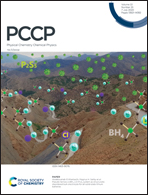Rate coefficients and product branching ratios for (E)-2-butenal + H reactions†
Abstract
Thermal rate constants for the hydrogen abstraction reactions of (E)-2-butenal by hydrogen atoms were calculated, for the first time, using the multipath canonical variational theory with small-curvature tunneling (MP-CVT/SCT). After a torsional potential energy surface exploration, ten conformations of the transition states (including the mirror images) were found and separated into four conformational reaction channels (CRCs). Individual energy paths of each CRC were built, recrossing and quantum tunneling effects estimated, and the thermal rate constants obtained. Due to the hindered rotors, the torsional anharmonicity was incorporated in the rate coefficient through the calculations of the rovibrational partition functions using the extended two-dimensional torsional method (E2DT). For comparison, the one-well (1W-CVT/SCT) and harmonic multipath (MP-CVT/SCT) thermal rate constants were also estimated. In addition, kinetic Monte Carlo (KMC) simulations were performed to predict the product branching ratios. For all kinetic approaches, the formation of products of (R1) is predominant. Compared to the harmonic multipath estimation, the percentage of reaction (R4) increases by approximately 9% when the torsional anharmonicity is taken into account. For the reactions (R2) and (R3), the product branching ratio is slightly decreased when compared with the harmonic simulation.



 Please wait while we load your content...
Please wait while we load your content...